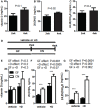The Gut Microbiota Regulates Endocrine Vitamin D Metabolism through Fibroblast Growth Factor 23
- PMID: 29599772
- PMCID: PMC5863497
- DOI: 10.3389/fimmu.2018.00408
The Gut Microbiota Regulates Endocrine Vitamin D Metabolism through Fibroblast Growth Factor 23
Abstract
To determine the effect of the microbiota on vitamin D metabolism, serum 25-hydroxyvitamin D(25D), 24,25-dihydroxyvitamin D (24,25D), and 1,25-dihydroxyvitamin D (1,25D) were measured in germ-free (GF) mice before and after conventionalization (CN). GF mice had low levels of 25D, 24,25D, and 1,25D and were hypocalcemic. CN of the GF mice with microbiota, for 2 weeks recovered 25D, 24,25D, and 1,25D levels. Females had more 25D and 24,25D than males both as GF mice and after CN. Introducing a limited number of commensals (eight commensals) increased 25D and 24,25D to the same extent as CN. Monocolonization with the enteric pathogen Citrobacter rodentium increased 25D and 24,25D, but the values only increased after 4 weeks of C. rodentium colonization when inflammation resolved. Fibroblast growth factor (FGF) 23 was extremely high in GF mice. CN resulted in an increase in TNF-α expression in the colon 2 days after CN that coincided with a reduction in FGF23 by 3 days that eventually normalized 25D, 24,25D, 1,25D at 1-week post-CN and reinstated calcium homeostasis. Neutralization of FGF23 in GF mice raised 1,25D, without CN, demonstrating that the high FGF23 levels were responsible for the low calcium and 1,25D in GF mice. The microbiota induce inflammation in the GF mice that inhibits FGF23 to eventually reinstate homeostasis that includes increased 25D, 24,25D, and 1,25D levels. The microbiota through FGF23 regulates vitamin D metabolism.
Keywords: fibroblast growth factor 23; inflammation; microbiota; tumor necrosis factor-α; vitamin D.
Figures








Similar articles
-
Regulation of vitamin D metabolism following disruption of the microbiota using broad spectrum antibiotics.J Nutr Biochem. 2018 Jun;56:65-73. doi: 10.1016/j.jnutbio.2018.01.011. Epub 2018 Feb 2. J Nutr Biochem. 2018. PMID: 29459310 Free PMC article.
-
1,25-dihydroxyvitamin D synthesis after renal transplantation: the role of fibroblast growth factor 23 and cyclosporine.Clin Transplant. 2009 Jun-Jul;23(3):368-74. doi: 10.1111/j.1399-0012.2009.00995.x. Clin Transplant. 2009. PMID: 19519602
-
Elevated fibroblast growth factor 23 exerts its effects on placenta and regulates vitamin D metabolism in pregnancy of Hyp mice.J Bone Miner Res. 2014 Jul;29(7):1627-38. doi: 10.1002/jbmr.2186. J Bone Miner Res. 2014. PMID: 24470103
-
[Current Topics on Vitamin D. Cross talks among vitamin D endocrine system, PTH and FGF23].Clin Calcium. 2015 Mar;25(3):341-7. Clin Calcium. 2015. PMID: 25716806 Review. Japanese.
-
The endocrine vitamin D system in the gut.Mol Cell Endocrinol. 2017 Sep 15;453:79-87. doi: 10.1016/j.mce.2016.11.028. Epub 2016 Nov 29. Mol Cell Endocrinol. 2017. PMID: 27913273 Review.
Cited by
-
[An updated review of the mechanism of fibrosis in acquired laryngotrachealstenosis].Lin Chuang Er Bi Yan Hou Tou Jing Wai Ke Za Zhi. 2022 Apr;36(4):310-314. doi: 10.13201/j.issn.2096-7993.2022.04.016. Lin Chuang Er Bi Yan Hou Tou Jing Wai Ke Za Zhi. 2022. PMID: 35511628 Free PMC article. Review. Chinese.
-
Vitamin D in Inflammatory Bowel Diseases. Mechanisms of Action and Therapeutic Implications.Nutrients. 2022 Jan 9;14(2):269. doi: 10.3390/nu14020269. Nutrients. 2022. PMID: 35057450 Free PMC article. Review.
-
Long-Duration Space Travel Support Must Consider Wider Influences to Conserve Microbiota Composition and Function.Life (Basel). 2022 Jul 30;12(8):1163. doi: 10.3390/life12081163. Life (Basel). 2022. PMID: 36013342 Free PMC article. Review.
-
Nutritional modulation of the intestinal microbiota; future opportunities for the prevention and treatment of neuroimmune and neuroinflammatory disease.J Nutr Biochem. 2018 Nov;61:1-16. doi: 10.1016/j.jnutbio.2018.04.004. Epub 2018 Apr 19. J Nutr Biochem. 2018. PMID: 29886183 Free PMC article. Review.
-
The Interplay between Gut Microbiota and Oral Medications and Its Impact on Advancing Precision Medicine.Metabolites. 2023 May 21;13(5):674. doi: 10.3390/metabo13050674. Metabolites. 2023. PMID: 37233715 Free PMC article. Review.
References
Publication types
MeSH terms
Substances
Grants and funding
LinkOut - more resources
Full Text Sources
Other Literature Sources
Medical

